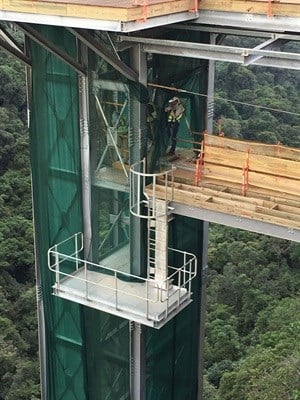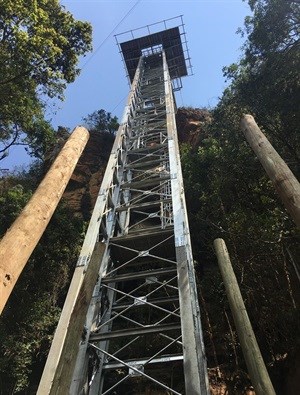






Eric Dixon, the director of LEW Consulting Engineers, said that when first approached four years ago to do the services report, he thought the project would not get off the ground. “The fact that it did happen is very exciting,” he says, adding that it is a testament to the developers’ tenacity.
LEW was appointed to do the structural and civil designs of the R40m Graskop Gorge development on Mpumalanga’s scenic Panorama Route, which includes the viewing elevator, a network of elevated walkways and suspension bridges at the foot of the cliff, and a restaurant, bar and shops on the plateau.
LEW’s structural engineer, Janine Fourie, explains that their involvement included the design of the 51m high steel lift shaft, with associated works; the design of all structural elements of the building; as well as the design of the parking area and entrance, stormwater, water and sewer reticulation and sewer pump station.
A highlight of the project for Dixon was seeing the lift shaft rise to level, with no problems in the manufacturing or erection of the structure.
Reiner Förtsch of Förtsch and Associates Architects used Dixon’s exact phrase – "pie in the sky" – when asked what he considered the most remarkable thing about the lift. “Clients come with grand ideas that are often nothing more than pipe dreams.”
Developer Campbell Scott, who has made a name for himself in adventure tourism across Africa, says the overall challenge of creating a unique visitor attraction to showcase the natural landscape, the gorge and forest is what excited him most about the project.
The Graskop Gorge lift is one of only two of its kind globally. “It represents the capacity and willingness of South Africa to move with the times and to show we can build world-class attractions not just for our foreign visitors but, most especially, for our growing domestic market,” says Scott.
He and fellow developers James Sheard – who was responsible for the opening in 2016 of Africa’s only rail toboggan, also on the Panorama Route; and Oupa Pilane, a local businessman with solid experience in the tourism sector, agree that with this not being an ‘off the shelf’ project, getting all the details right, on time and on budget, has been challenging.
“We have rolled up our sleeves and dived in but we have also had a great team prepared to do the same,” says Scott.

He says they have had excellent support from the Thaba Chweu Municipality and the greater tourism community, as well as the National Empowerment Fund (NEF). “The NEF has been excellent; I am honestly not sure we would have been able to achieve what we have without them. They bring a lot more to the party than just funding and they have lots of experience with regard to large-scale developments.”
The developers have a long-term lease with the Thaba Chweu Municipality, which owns the land, and obtained funding through the NEF. The rest of the shares are privately held.
“Seeing the attraction take shape was an awe-inspiring feeling,” Scott says. “It’s not something you can plan on paper; you just have to believe in it. It’s not about any one thing; it’s the combination of everything that creates the experience and it’s awesome.”
Earthbound Timber Designs was responsible for building the walkways and doing the decking both on the plateau where the retail offering and restaurant are located, and at the bottom of the gorge, where environmental trails weave through the escarpment’s afromontane forest.
The company was also responsible for replacing the derelict staircase down the gorge that had fallen into disrepair. Earthbound Timber’s Vincent Cant says that this involved 125 linear metres and a drop of roughly 70 metres, with an average of between 40 and 60 degrees.
Förtsch says the rocky outcrops at the cliff’s edge necessitated the construction of a raised platform to house the buildings, all of which were designed to maximise the views and reflect the surroundings, with lots of glass and open spaces, big wood rafters and terraces.

Wayne Hattingh from Enza Construction, the main contractor on site, says the uniqueness of the project and the space limitations at the gorge’s edge posed major issues with regards to craneage.
“The short time frame to complete the project along with the access and concrete works at the bottom of the gorge created a unique problem in that we were not able to go the conventional route of casting concrete with a crane,” says Hattingh. “Not only would such a process have taken us weeks to complete, but the sheer size of the crane required to do the work would not have been cost effective. We had to think outside the box and created a ‘shoot system’ on top of the gorge that allowed us to drop the concrete in a controlled manner approximately 51m vertically.
“This drop caused its own problems due to the limitations of SANS 1200G specification Clause 5.5.5.5, which reads: ‘Concrete shall not be allowed to fall freely through a height of more than 3m, unless otherwise approved’.
“Fortunately, our concrete supplier in Hazyview had encountered a similar challenge on a previous mining project and was able to provide us with a special mix that was able to be dropped vertically up to 150m and also drastically reduced our curing time in the base.
“What could have taken us one-and-a-half months, including the curing, took us only a week-and-a half to complete,” he says.
The lift shaft assembly also posed problems. On most sites, a 70-tonne crane would have done the job but because of the depth of the gorge and the limited space at the cliff’s edge, the crane’s reach posed a problem.
“In addition, in order to install the shaft, we had to pre-assemble sections on top and then lower them down. However, the required sections were too heavy to safely drop into place with a 70-tonne crane. The amount of cable available on a 70-tonne crane was also problematic.
“Eventually, we acquired one of only a few mobile tower cranes in the country, which had the required reach and load capability. The cable issues were resolved by rigging the lower sections in place with an extended heavy-duty chain.”
Hattingh says the topography of the site on top of the gorge also necessitated some innovation. “The structure above floor level is fairly standard; however, the foundation work was not, due to the presence of rocky outcrops. There were instances where the southern foundations walls were 1.2m above natural ground level but four metres to the north, the same foundation wall was around 6m above natural ground level due to the extreme slope in the area.
“The boulders were left intact to keep the natural rock features inside of the foundation walls, which make for a very unique feature.”